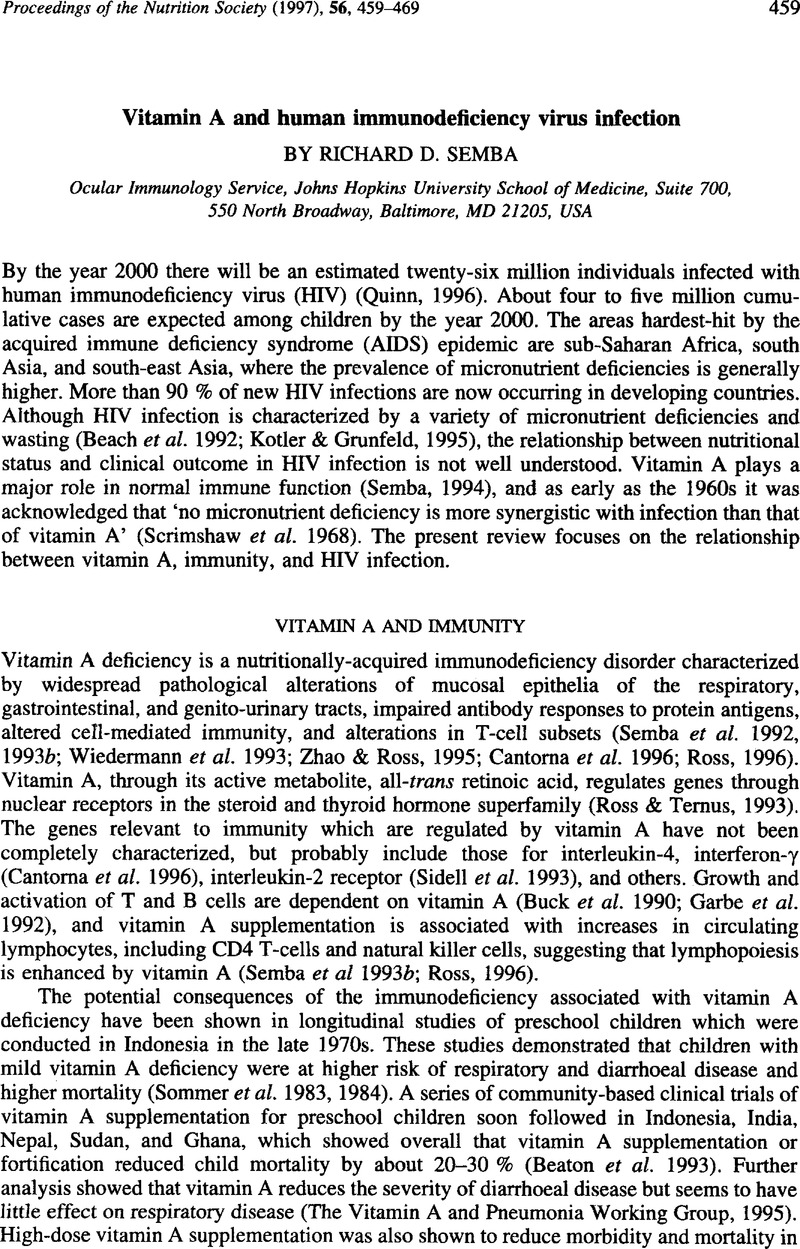Crossref Citations
This article has been cited by the following publications. This list is generated based on data provided by Crossref.
Giaquinto, C
Ruga, E
Giacomet, V
Rampon, O
and
D'Elia, R
1998.
HIV: mother to child transmission, current knowledge and on‐going studies.
International Journal of Gynecology & Obstetrics,
Vol. 63,
Issue. S1,
Hayes, C. E.
Nashold, F. E.
Gomez, F. Enrique
and
Hoag, K. A.
1999.
Retinoids.
Vol. 139,
Issue. ,
p.
589.
Kelly, Paul
Musonda, Rosemary
Kafwembe, Emmanuel
Kaetano, Lovemore
Keane, Eileen
and
Farthing, Michael
1999.
Micronutrient supplementation in the AIDS diarrhoea-wasting syndrome in Zambia: A randomized controlled trial.
Aids,
Vol. 13,
Issue. 4,
p.
495.
Semba, R. D.
and
Tang, A. M.
1999.
Micronutrients and the pathogenesis of human immunodeficiency virus infection.
British Journal of Nutrition,
Vol. 81,
Issue. 3,
p.
181.
Calder, Philip C.
and
Jackson, Alan A.
2000.
Undernutrition, infection and immune function.
Nutrition Research Reviews,
Vol. 13,
Issue. 1,
p.
3.
Mehendale, Sanjay M.
Shepherd, Mary E.
Brookmeyer, Ronald S.
Semba, Richard D.
Divekar, Anand D.
Gangakhedkar, Raman R.
Joshi, Smita
Risbud, Arun R.
Paranjape, Ramesh S.
Gadkari, Deepak A.
and
Bollinger, Robert C.
2001.
Low Carotenoid Concentration and the Risk of HIV Seroconversion in Pune, India.
JAIDS Journal of Acquired Immune Deficiency Syndromes,
Vol. 26,
Issue. 4,
p.
352.
Semba, Richard
2001.
Micronutrients and HIV Infection.
Vol. 20011025,
Issue. ,
p.
73.
Stephensen, Charles B
2001.
VITAMINA, INFECTION,ANDIMMUNEFUNCTION*.
Annual Review of Nutrition,
Vol. 21,
Issue. 1,
p.
167.
Mehendale, Sanjay M.
Shepherd, Mary E.
Brookmeyer, Ronald S.
Semba, Richard D.
Divekar, Anand D.
Gangakhedkar, Raman R.
Joshi, Smita
Risbud, Arun R.
Paranjape, Ramesh S.
Gadkari, Deepak A.
and
Bollinger, Robert C.
2001.
Low Carotenoid Concentration and the Risk of HIV Seroconversion in Pune, India.
Journal of Acquired Immune Deficiency Syndromes,
Vol. 26,
Issue. 4,
p.
352.
Kelly, P.
Musuku, J.
Kafwembe, E.
Libby, G.
Zulu, I.
Murphy, J.
and
Farthing, M. J. G.
2001.
Impaired bioavailability of vitamin A in adults and children with persistent diarrhoea in Zambia.
Alimentary Pharmacology & Therapeutics,
Vol. 15,
Issue. 7,
p.
973.
Semba, Richard D.
and
Gray, Glenda E.
2001.
Pathogenesis of Anemia during Human Immunodeficiency Virus Infection.
Journal of Investigative Medicine,
Vol. 49,
Issue. 3,
p.
225.
Hoag, Kathleen A.
Nashold, Faye E.
Hayes, Colleen E.
and
Goverman, Joan
2002.
Retinoic Acid Enhances the T Helper 2 Cell Development That Is Essential for Robust Antibody Responses through Its Action on Antigen-Presenting Cells.
The Journal of Nutrition,
Vol. 132,
Issue. 12,
p.
3736.
Kiure, Annamaria K.
Msamanga, Gernard I.
and
Fawzi, Wafaie W.
2002.
AIDS in Africa.
p.
419.
Visser, M. E.
Maartens, G.
Kossew, G.
and
Hussey, G. D.
2003.
Plasma vitamin A and zinc levels in HIV-infected adults in Cape Town, South Africa.
British Journal of Nutrition,
Vol. 89,
Issue. 4,
p.
475.
Kiure, Annamaria
and
Fawzi, Wafaie
2004.
Handbook of Nutrition and Immunity.
p.
303.
Goldrosen, Martin H.
and
Straus, Stephen E.
2004.
Complementary and alternative medicine: assessing the evidence for immunological benefits.
Nature Reviews Immunology,
Vol. 4,
Issue. 11,
p.
912.
Zmarzły, Anna
Simon, Krzysztof
Krause, Krzysztof
Rotter, Katarzyna
Ga̧siorowski, Jacek
Zalewska, Małgorzata
and
Piasecki, Egbert
2004.
Retinol–vitamin A in HIV-infected patients who are former intravenous drug users.
Nutrition Research,
Vol. 24,
Issue. 6,
p.
427.
Semba, Richard D.
Ndugwa, Christopher
Perry, Robert T.
Clark, Tamara D.
Jackson, J. Brooks
Melikian, George
Tielsch, James
and
Mmiro, Francis
2005.
Effect of periodic vitamin A supplementation on mortality and morbidity of human immunodeficiency virus–infected children in Uganda: A controlled clinical trial.
Nutrition,
Vol. 21,
Issue. 1,
p.
25.
Kazi, Tasneem G.
Afridi, Hassan I.
Kazi, Gul H.
Jamali, Mohammad K.
Arain, Mohammad B.
and
Jalbani, Nusrat
2006.
Evaluation of essential and toxic metals by ultrasound-assisted acid leaching from scalp hair samples of children with macular degeneration patients.
Clinica Chimica Acta,
Vol. 369,
Issue. 1,
p.
52.
Kassu, Afework
Van Nhien, Nguyen
Nakamori, Masayo
Diro, Ermias
Ayele, Belete
Mengistu, Getahun
Wondmikun, Yared
Nishikawa, Takeshi
Yamamoto, Shigeru
and
Ota, Fusao
2007.
Deficient serum retinol levels in HIV-infected and uninfected patients with tuberculosis in Gondar, Ethiopia.
Nutrition Research,
Vol. 27,
Issue. 2,
p.
86.





